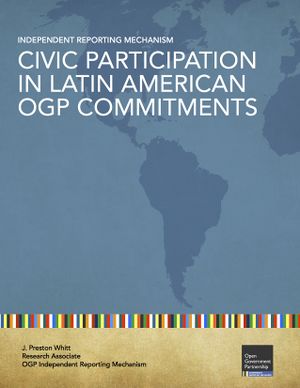Difference between revisions of "J. Preston Whitt (2014) Independent Reporting Mechanism. Civic Participation in Latin American OGP Commitments"
| Line 1: | Line 1: | ||
| − | + | [[File: LatAm Participation Web-img.jpg | thumbnail | right]] | |
| − | + | == <small>'''Abstract'''</small> == | |
| − | |||
| − | + | The Open Government Partnership (OGP) Independent Reporting Mechanism (IRM) is a key means by which all stakeholders can track OGP progress in participating countries. The IRM produces independent progress reports on action plan commitments for each country participating in OGP. Using a sample of 88 “civic participation” commitments from Latin America, this discussion paper investigates several questions: | |
| − | (IRM) is a key means by which all stakeholders can track OGP progress in | ||
| − | participating countries. The IRM produces independent progress reports on | ||
| − | action plan commitments for each country participating in OGP. Using a sample | ||
| − | of 88 “civic participation” commitments from Latin America, this discussion | ||
| − | paper investigates several questions: | ||
| − | |||
| − | |||
| − | |||
| − | |||
| − | |||
| − | |||
| − | |||
| − | |||
| − | |||
| − | |||
| − | |||
| − | |||
| − | |||
| − | |||
| − | |||
| − | |||
| − | |||
| − | |||
| − | |||
| − | |||
| − | |||
| − | |||
| − | |||
| − | |||
| − | [[ | + | 1. How much additional influence do citizens have to observe, inform, shape, and engage in decision-making as a result of OGP commitments?<br /> |
| − | [[ | + | 2. Were participation commitments with higher levels of potential public impact actually completed?<br /> |
| − | [[ | + | 3. Did the commitments improve or deepen existing participatory processes or did they open participation in policy spaces that were previously closed?<br /> |
| − | [[ | + | 4. Did participation commitments have a higher or lower potential impact if they used technology?<br /> |
| − | [[ | + | |
| − | [[ | + | The results show that the majority of commitments had some form of two-way communication, but a minority of commitments had a direct means of public influence. Additionally, an increasing level of potential public impact is not correlated to completion or incompletion. The findings also show that most commitments focused on improving already existing participatory areas. Finally, while the data is inconclusive, technology-oriented commitments often seem to have a significant potential impact. |
| + | |||
| + | The paper’s goal is to provide some useful points of departure for OGP stakeholders to support governments and civil societies, to advocate for and to design commitments, and to carry out a future research agenda on participation within the OGP. | ||
| + | |||
| + | == <small>'''File'''</small> == | ||
| + | |||
| + | [[File: LatAm Participation Web.pdf]] | ||
| + | |||
| + | == <small>'''Source'''</small> == | ||
| + | |||
| + | [[Alianza_para_el_Gobierno_Abierto/Open_Government_Partnership | Alianza para el Gobierno Abierto/Open Government Partnership]] | ||
| + | |||
| + | == <small>'''Links'''</small> == | ||
| + | |||
| + | '''URL:''' http://www.opengovpartnership.org/sites/default/files/attachments/LatAm%20Participation%20Web.pdf | ||
| + | |||
| + | '''Wayback Machine:''' https://web.archive.org/web/*/http://www.opengovpartnership.org/sites/default/files/attachments/LatAm%20Participation%20Web.pdf | ||
| + | |||
| + | [[Category:Library]] | ||
| + | [[Category:Open Government Partnership]] | ||
| + | [[Category:J.Preston Whitt]] | ||
| + | [[Category:English]] | ||
| + | [[Category:USA]] | ||
| + | [[Category:2014]] | ||
Latest revision as of 00:47, 24 April 2017
Contents
Abstract
The Open Government Partnership (OGP) Independent Reporting Mechanism (IRM) is a key means by which all stakeholders can track OGP progress in participating countries. The IRM produces independent progress reports on action plan commitments for each country participating in OGP. Using a sample of 88 “civic participation” commitments from Latin America, this discussion paper investigates several questions:
1. How much additional influence do citizens have to observe, inform, shape, and engage in decision-making as a result of OGP commitments?
2. Were participation commitments with higher levels of potential public impact actually completed?
3. Did the commitments improve or deepen existing participatory processes or did they open participation in policy spaces that were previously closed?
4. Did participation commitments have a higher or lower potential impact if they used technology?
The results show that the majority of commitments had some form of two-way communication, but a minority of commitments had a direct means of public influence. Additionally, an increasing level of potential public impact is not correlated to completion or incompletion. The findings also show that most commitments focused on improving already existing participatory areas. Finally, while the data is inconclusive, technology-oriented commitments often seem to have a significant potential impact.
The paper’s goal is to provide some useful points of departure for OGP stakeholders to support governments and civil societies, to advocate for and to design commitments, and to carry out a future research agenda on participation within the OGP.
File
File:LatAm Participation Web.pdf
Source
Alianza para el Gobierno Abierto/Open Government Partnership
Links
URL: http://www.opengovpartnership.org/sites/default/files/attachments/LatAm%20Participation%20Web.pdf
Wayback Machine: https://web.archive.org/web/*/http://www.opengovpartnership.org/sites/default/files/attachments/LatAm%20Participation%20Web.pdf
